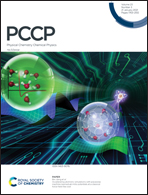Stability, edge passivation effect, electronic and transport properties of POPGraphene nanoribbons
Abstract
POPGraphene is a theoretically predicted 2D carbon allotrope which presents a unit cell with 5–8–5 carbon rings. It presents metallic behavior and has a low diffusion energy barrier, which suggests applications as an anode material in batteries. Motivated by the fact that nanoribbons present different properties to their 2D counterparts, in this work two kinds of POPGraphene nanoribbons were proposed, with (POPGNRH) and without (POPGNR) hydrogen edge passivation, and their electronic and transport properties were investigated, in order to characterize them and verify the influence of hydrogen edge passivation. Density functional theory was employed for structure optimization and combined with the Non-Equilibrium Green's Function to obtain the electronic transport properties. We predict that both nanoribbons are stable and can be obtained experimentally. Furthermore, hydrogen passivation reduces the bands around the Fermi level and shift them toward the region of negative energies, which can be seen from the presence of NDR in the transport properties of the hydrogenated device. The electronic transport properties suggest that POPGNR shows Field effect transistor behavior in the analyzed range and POPGNRH shows the same behavior, but in the range of −0.70 V to 0.70 V. Also, due to the presence of NDR, POPGNRH presents Resonant Tunneling Diode behavior in the range of ±0.70 V to ±1.00 V. Therefore, the results suggest applications for both nanoribbons in the field of molecular electronics.



 Please wait while we load your content...
Please wait while we load your content...